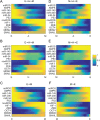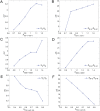A Dimension Reduction Approach for Energy Landscape: Identifying Intermediate States in Metabolism-EMT Network
- PMID: 34026435
- PMCID: PMC8132071
- DOI: 10.1002/advs.202003133
A Dimension Reduction Approach for Energy Landscape: Identifying Intermediate States in Metabolism-EMT Network
Abstract
Dimension reduction is a challenging problem in complex dynamical systems. Here, a dimension reduction approach of landscape (DRL) for complex dynamical systems is proposed, by mapping a high-dimensional system on a low-dimensional energy landscape. The DRL approach is applied to three biological networks, which validates that new reduced dimensions preserve the major information of stability and transition of original high-dimensional systems. The consistency of barrier heights calculated from the low-dimensional landscape and transition actions calculated from the high-dimensional system further shows that the landscape after dimension reduction can quantify the global stability of the system. The epithelial-mesenchymal transition (EMT) and abnormal metabolism are two hallmarks of cancer. With the DRL approach, a quadrastable landscape for metabolism-EMT network is identified, including epithelial (E), abnormal metabolic (A), hybrid E/M (H), and mesenchymal (M) cell states. The quantified energy landscape and kinetic transition paths suggest that for the EMT process, the cells at E state need to first change their metabolism, then enter the M state. The work proposes a general framework for the dimension reduction of a stochastic dynamical system, and advances the mechanistic understanding of the underlying relationship between EMT and cellular metabolism.
Keywords: dimension reduction; energy landscape; epithelial‐mesenchymal transitions; gene regulatory networks; transition paths.
© 2021 The Authors. Advanced Science published by Wiley‐VCH GmbH.
Conflict of interest statement
The authors declare no conflict of interest.
Figures







Similar articles
-
Landscape and kinetic path quantify critical transitions in epithelial-mesenchymal transition.Biophys J. 2021 Oct 19;120(20):4484-4500. doi: 10.1016/j.bpj.2021.08.043. Epub 2021 Sep 2. Biophys J. 2021. PMID: 34480928 Free PMC article.
-
Energy Landscape Analysis of the Epithelial-Mesenchymal Transition Network.Methods Mol Biol. 2022;2488:145-157. doi: 10.1007/978-1-0716-2277-3_11. Methods Mol Biol. 2022. PMID: 35347688
-
Exposing the Underlying Relationship of Cancer Metastasis to Metabolism and Epithelial-Mesenchymal Transitions.iScience. 2019 Nov 22;21:754-772. doi: 10.1016/j.isci.2019.10.060. Epub 2019 Oct 31. iScience. 2019. PMID: 31739095 Free PMC article.
-
Emerging Concepts of Hybrid Epithelial-to-Mesenchymal Transition in Cancer Progression.Biomolecules. 2020 Nov 16;10(11):1561. doi: 10.3390/biom10111561. Biomolecules. 2020. PMID: 33207810 Free PMC article. Review.
-
Phenotypic Plasticity and Cell Fate Decisions in Cancer: Insights from Dynamical Systems Theory.Cancers (Basel). 2017 Jun 22;9(7):70. doi: 10.3390/cancers9070070. Cancers (Basel). 2017. PMID: 28640191 Free PMC article. Review.
Cited by
-
Perspectives on computational modeling of biological systems and the significance of the SysMod community.Bioinform Adv. 2024 Jun 26;4(1):vbae090. doi: 10.1093/bioadv/vbae090. eCollection 2024. Bioinform Adv. 2024. PMID: 38948011 Free PMC article.
-
Quantitative landscapes reveal trajectories of cell-state transitions associated with drug resistance in melanoma.iScience. 2022 Nov 4;25(12):105499. doi: 10.1016/j.isci.2022.105499. eCollection 2022 Dec 22. iScience. 2022. PMID: 36425754 Free PMC article.
-
Perspectives on the landscape and flux theory for describing emergent behaviors of the biological systems.J Biol Phys. 2022 Mar;48(1):1-36. doi: 10.1007/s10867-021-09586-5. Epub 2021 Nov 25. J Biol Phys. 2022. PMID: 34822073 Free PMC article. Review.
-
Network modeling-based identification of the switching targets between pyroptosis and secondary pyroptosis.Chaos Solitons Fractals. 2022 Feb;155:111724. doi: 10.1016/j.chaos.2021.111724. Epub 2022 Jan 2. Chaos Solitons Fractals. 2022. PMID: 36570873 Free PMC article.
-
Inferring structural and dynamical properties of gene networks from data with deep learning.NAR Genom Bioinform. 2022 Sep 13;4(3):lqac068. doi: 10.1093/nargab/lqac068. eCollection 2022 Sep. NAR Genom Bioinform. 2022. PMID: 36110897 Free PMC article.
References
-
- Abdi H., Williams L. J., Wiley Interdiscip. Rev.: Comput. Stat. 2010, 2, 433.
-
- Ye J., Janardan R., Li Q., in Advances in Neural Information Processing Systems, MIT Press, Cambridge, MA: 2005, pp. 1569–1576.
-
- Roweis S. T., Saul L. K., Science 2000, 290, 2323. - PubMed
-
- Maaten L. v. d., Hinton G., J. Mach. Learning Res. 2008, 9, 2579.
Publication types
LinkOut - more resources
Full Text Sources
Other Literature Sources
